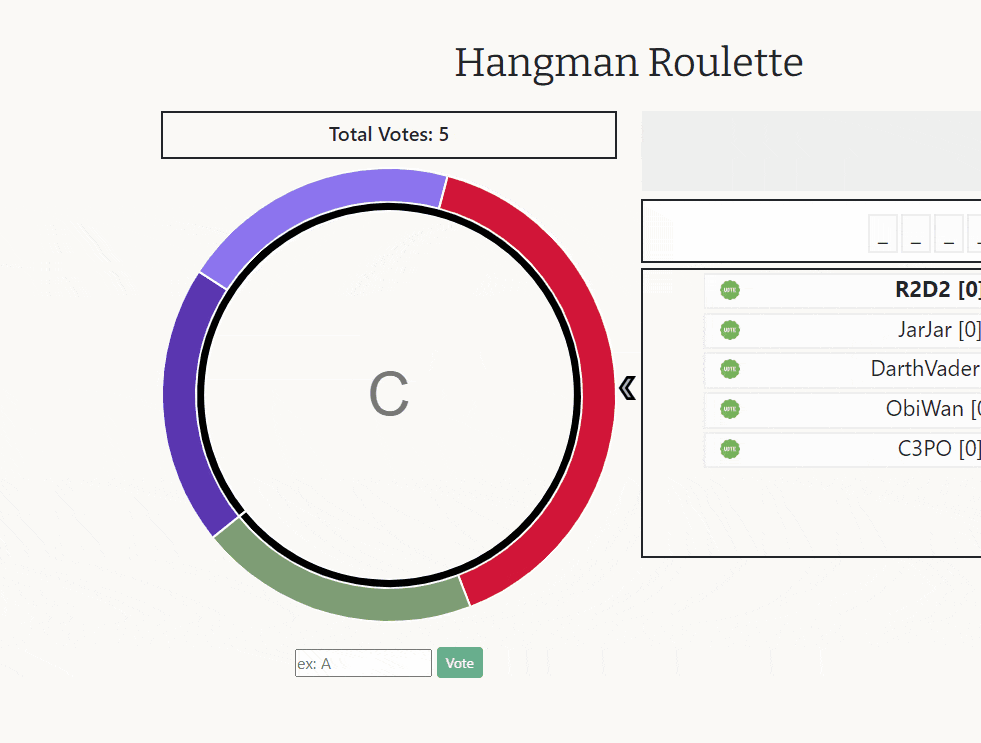I combined two ideas into a game and it’s my new favorite thing.
written by Sean Collan Fong
After attending club workshops at my university and learning backend development from online courses, I had the ability to create something I had always wanted to do. And my friends love it too!
Background
Every time I see my friends play hangman on the whiteboards in the study rooms, it always comes down to everyone guessing a letter person-by-person and arguing who would take the next turn. And sometimes the game would bore on because the person who thought of the word made it too complicated for everyone.
I wanted to solve this by creating a system that encouraged both teamwork and competition, as well as a scoreboard to make things more interesting.
Reinventing the wheel
Originally, I wanted to create a game where people would vote a letter, and everyone would see a bar chart with the most-voted letters. And after a fixed timer, the system would choose the letter with the most votes.
I was walking with a friend and mentioned this idea to him who then suggested the idea of having everyone's votes in a donut chart. Instead of choosing the highest-voted letter and arbitrarily break ties, I could have everyone's vote occupy an equal amount of space on the wheel and spin it to have the thrill of randomness.
Implementation
When I developed this project, I did not have much experience in frontend frameworks that I use nowadays. However, all I knew I needed was an Express backend which would handle all the socket.io connections and game logic and just serve static HTML and CSS files to the users. In my opinion, a lot of the code was more-or-less all over the place. However, in the end it really taught me how important modularity is, especially for large projects.
For the frontend, I was able to manage whipping something up super fast with Bootstrap, although it does come with some limitations, especially since I wanted to customize a lot of elements. Nonetheless, I was able to create a responsive layout, so anyone could easily connect on their phone or laptop.
To create the spinning wheel, I used Chart.JS and their built-in doughnut chart. However, I needed to create a custom plugin in order to display the current letter when the wheel was spinning.
const counterPlugin = {
id: 'counter',
beforeDraw(chart, args, options) {
const {ctx, chartArea: {
top, right, bottom, left, width, height
}} = chart;
ctx.save();
ctx.font = options.fontSize + 'px ' + options.fontFamily;
ctx.textAlign = 'center';
ctx.fillStyle = options.fontColor;
ctx.fillText(options.chartText, width / 2, top + (height / 2) + (options.fontSize * 0.34));
}
}I also decided to leverage some built-in libraries, such as Sweet Alert, which made it easy to create a customizable Toast notification for when users enter the game and notify score changes.
Gameplay
Although I faced some hardships during the development process, I was able to get a result that I was really satisfied with, especially for a beginner-like project.
The Gameplay Cycle:
Here's a short clip of how the game is played:

- Every player anonymously votes on a letter
- Every player's letter vote gets added onto the wheel. If two people vote the same letter, the space gets shared.
- After a fixed timer ends, the wheel spins and the game chooses the letter it lands on.
- Players gain points if their letter was chosen and it is in the word.
- If a letter is not in the word, then everyone who did not vote the letter gets a point.
- Players who don't vote get no points.
Conclusion
Overall, this was actually a more enjoyable experience than I had anticipated. Even though I had done an extensive amount of programming for coursework, this was my first large personal project. Furthermore, it had fueled my excitement for exploring full stack development because I had to be capable of managing both the server and the client.
More importantly, however, was that I had learned how much more convenient having a frontend framework is. Having to manually update the HTML on socket events was very tedious, and without a framework that manages states such as React, I had made sure to mark learning frontend development as the next bullet point in my journey.